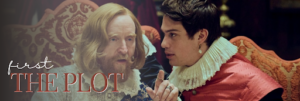Mary & George, a new British period miniseries that has just been released on Starz and Sky Atlantic for American audiences starring Julianne Moore and Nicholas Galitzine as the main protagonists.
Based on the non-fiction novel, The King’s Assassin (2017) by Benjamin Woolley, the drama follows the romantic affair between James VI of England, and George Villiers, Duke of Buckingham. While it has received many positive reviews from critics, here’s what is known so far of this intriguing interpretation.
First, The Plot

The story is set in the early 1600s and follows Mary Beaumont, who has become penniless after the death of her first husband. In an effort to turn her fortunes around, she begins plotting how she can use her second son, George,’s striking good looks to her advantage. This is aided by rumors that King James (Tony Curran), who surrounds himself with a plethora of male courtiers, is growing tired of his favorite, Richard Carr.
This prompts Mary to persuade George to seduce the King, granting them the status and power they deserve. This plan, however, is not as simple as it appears, and George must resort to scheming and backstabbing in a darkly comic, lushly erotic, and boldly anachronistic homage to history.
The plot has a lot of dramatic license in the details, but like any period drama, it is supported by fact. Even though it’s not a novel concept, the notion of controlling a volatile monarch through sex is still very intriguing. Despite the obvious influence of films like The Favorite and Jeanne du Berry, Mary and George manages to stand deliciously apart thanks to its bewildering array of alliances, betrayals, and breakups.
Second, the Costumes

Annie Symons was the chief costume designer behind this show, and one must applaud the right amount of camp that she delivers in making Jacobean fashion sexy. After all, the hats, ruffles, jewels, and fabrics represent English court fashion when it was at its most flamboyant.
During the show’s time period 1603-1625, the fashion changed from the enormous farthingales of Queen Elizabeth I to a more softer and wearable appearance. The waistlines creep up higher and higher and the fabrics become more extravagant.
One of the challenges with the costumes was that there aren’t very many archives when it comes to Jacobean or Elizabethan clothing which meant that the garments don’t represent total accuracy, but that’s okay. Instead, Symons uses any gaps in her research to use the clothing as a symbol to represent the character’s ambitions. For example, in the beginning of the series Mary wears a depleted look stripped of color and devoid of accessories, but as she moves forward in her social status along with her son, her outfits become more and more emboldened.
The only character that seems to be following her own trend is Miss Brookes (Niamh Algar) who wears completely modern hairstyles, and makeup, and somehow looks more cottage-core than tailored to the time period. Even though she is supposed to represent a prostitute who rises to the ranks, her clothing just doesn’t fit in the period throughout the series.
Third, the Acting

The characters are full of attitude, humor, and arrogance, but they fall short in terms of personality and storyline. Julianne Moore is ideal for the part in every way. She exudes a fierce and haughty desperation that adds much enjoyment to the show. Tony Curran, whose acting is amazing as he follows a chaotic individual throughout the series, also does this.
However, Nicholas Galitzine doesn’t seem to develop a strong enough character to support the narrative. That’s all he is—a pretty face. Though the audience can clearly sense his thoughts and feelings due to his compelling emotions, the dialogue is just not there.
Like always, the background characters are truly the stars of the show and deliver an atmosphere that makes the show worth watching. Individual actors like Pearl Chanda (Frances Carr, Countess of Somerset) and Trine Dyrholm (Queen Anne) deliver a modern but compelling interpretation of 17th-century court life.
Closing remarks
All things considered, Mary and George deserves a 7 out of 10. Like any period drama, it’s up for interpretation, but it still meets the audience’s cravings for sensual costumes and potent dialogue, which add to the show’s unique flavor.

Leave a Reply